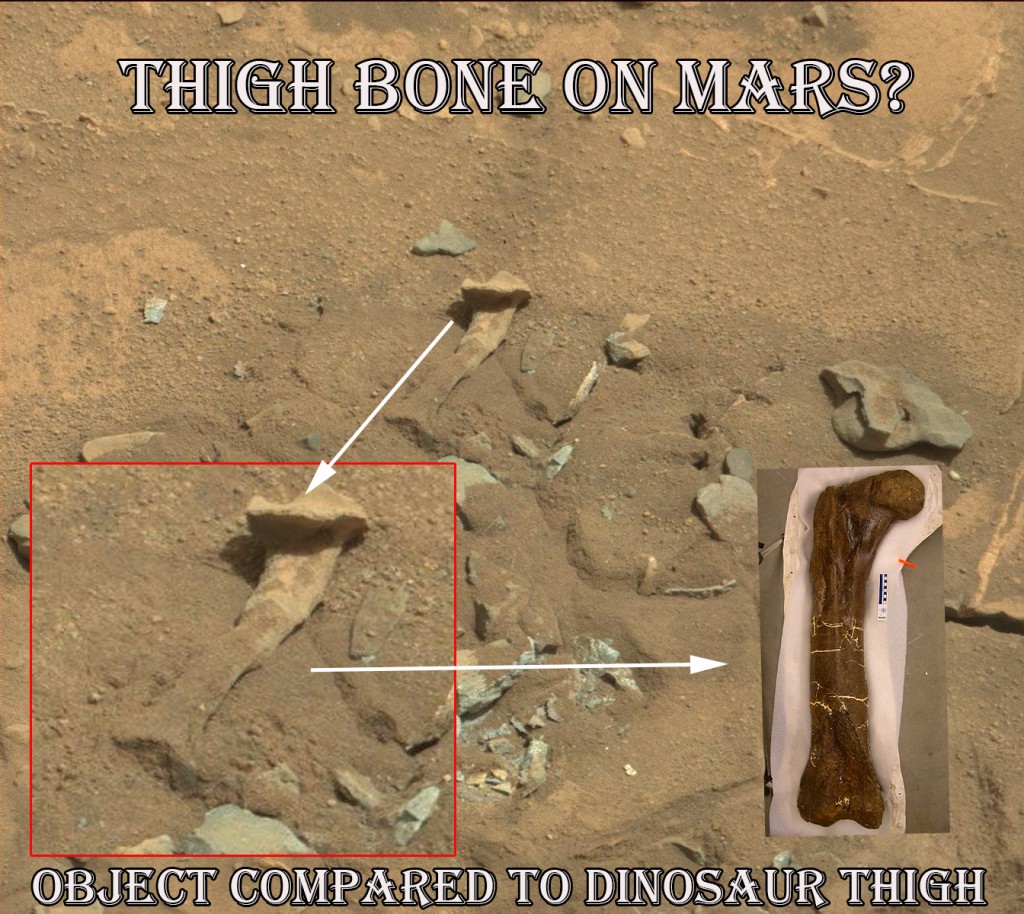On August 14, the Mars Curiosity Rover photographed an object that appears to be a thigh bone on the Martian surface. When the photo was released by NASA’s JPL affiliate a few days later, initial observers claimed that the object was a fossilized bone fragment. The first thigh fossil claims on August 20 generated much media attention and public controversy with coverage by major media outlets such as the Huffington Post and Britain’s Daily Mirror In an unusually quick response, NASA replied to the growing controversy on August 21 by claiming that the object was little more than a rock. Today, Science.com released a story backing NASA’s claim that the photo is nothing more than a rock. Not so according to a growing number of independent researchers that have uncovered past Curiosity Rover images of what appear to be different life forms on the Mars surface.
The image was taken by Curiosity Rover’s Mastcam which provides high resolution panoramic color images of the Mars environment. Among the first observers of the thigh looking object was the popular website UFO Blogger that released a post on August 20 claiming:
After fossilized spine and finger now NASA Curiosity on August 14, 2014 photographed fossilized thigh bone-like object on Mars.
As major media sources began giving UFO Blogger claims wide coverage, NASA quickly released a statement on August 21 dismissing the notion that the object is a thigh bone:
No bones about it! Seen by Mars rover Curiosity using its MastCam, this Mars rock may look like a femur thigh bone. Mission science team members think its shape is likely sculpted by erosion, either wind or water. If life ever existed on Mars, scientists expect that it would be small simple life forms called microbes. Mars likely never had enough oxygen in its atmosphere and elsewhere to support more complex organisms. Thus, large fossils are not likely.
While Space.com and other major media outlets appear satisfied by NASA’s explanation, independent researchers disagree. In fact, past Mars Rover images show what clearly appear to be animals roving the Mars surface.
In August February 2013, for example, a Curiosity Rover photo showed what appeared to be a duck on Mars. Another Rover Curiosity image taken in February 2013, showed what looked like a lizard on the Mars surface. In yet another photo from Curiosity Rover captured on September 2012, a squirrel appears to be on Mars. Finally, in a series of five images captured by the Spirit Rover in 2009, an object clearly appears to have moved; curiously, NASA experts refused to comment.
NASA’s explanation that all the above images are merely rocks appearing to be animals or fossils generates heated controversy not only in the general public, but among NASA scientists themselves. Richard Hoover worked for NASA as an astrobiologist for 46 years, and claims that in 2004, the Mars Rover, Opportunity photographed what clearly looked like the fossilized remains of a crinoid, a marine animal that looks like a sea lily. Hoover showed it to colleagues who immediately recognized the object as a crinoid. However, rather than examine the exciting possibility that Opportunity had photographed the fossilized remains of a living organism, Hoover said that less than four hours after taking the photo, Opportunity’s rock abrasion tool ground the area where the possible fossil lay into dust. He asked David McKay, the former chief astrobiologist at the Johnson Space Center, why this had been done. According to Hoover, the answer he received was less than satisfactory. Hoover’s conclusion was that senior NASA scientists were actively destroying evidence of Martian fossils.
If animals do roam the Martian surface, as Mars Rover photographs suggest, then bone fossils and bone fragments will also likely be detected on the Mars surface as Hoover claims. Photographic and whistleblower evidence suggest that NASA’s explanations that Mars Rover images are nothing more than rocks, appear to be obfuscations designed to mislead the general public about the true composition of the Mars atmosphere and of life on Mars.
© Michael E. Salla, Ph.D. Copyright Notice

